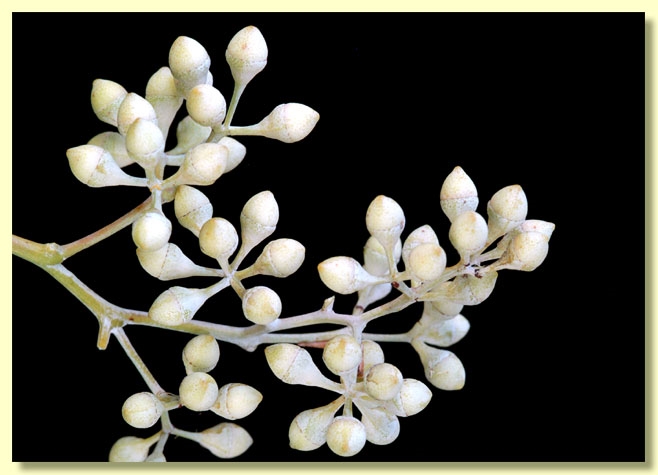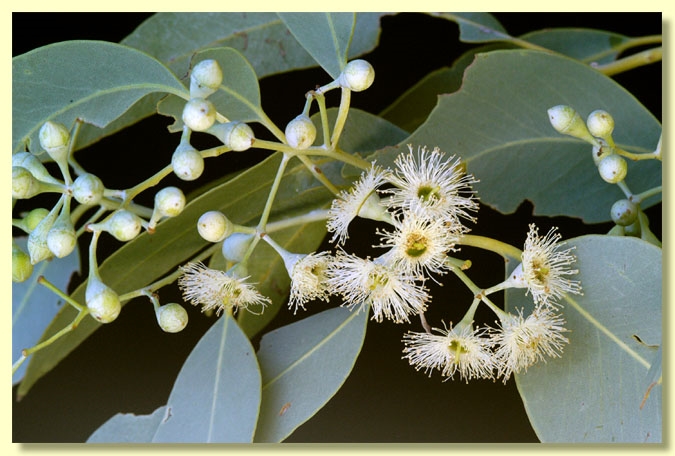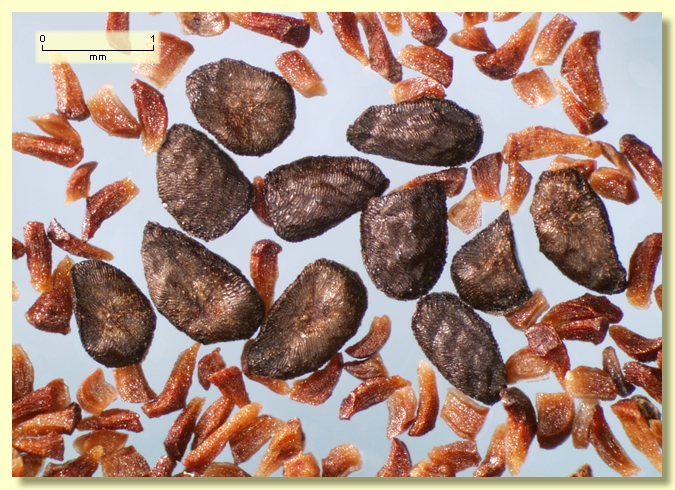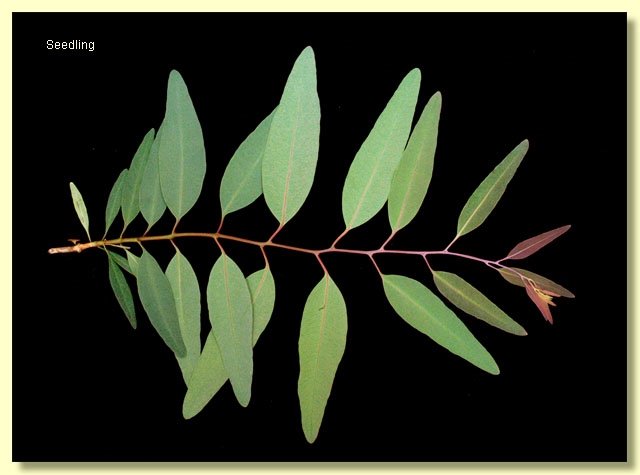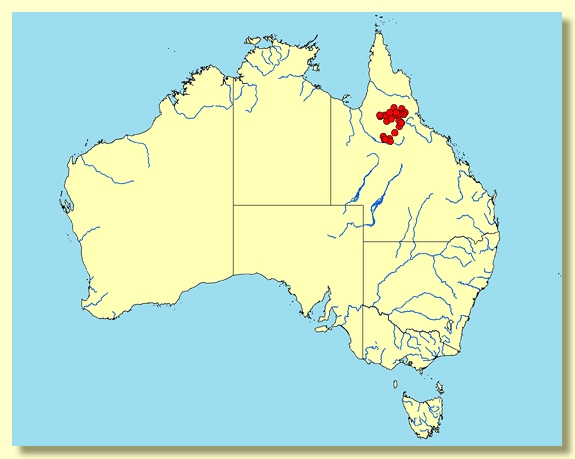Euclid - Online edition
Eucalyptus microneura
Eucalyptus | Symphyomyrtus | Adnataria | Apicales | Aquilonares | Protrusae
Tree to 10 m tall, occasionally taller to 15 m. Forming a lignotuber.
Bark rough throughout, box-type, finely fissured, grey.
Branchlets lacking oil glands in the pith; normally glaucous, occasionally non-glaucous.
Juvenile growth (coppice or field seedlings to 50 cm): stems rounded in cross-section; juvenile leaves always petiolate, alternate, lanceolate, dull grey-green to blue-grey to glaucous.
Adult leaves alternate, petioles 1.3–3 cm long; blade lanceolate, 5–11(15.5) cm long, 1.6–3(4) cm wide, base tapering to petiole, rarely rounded, apex pointed, margin entire, concolorous to slightly discolorous, dull, blue-grey to grey-green to glaucous to occasionally green, side-veins at an acute angle or at an angle greater than 45° to midrib, reticulation very dense, intramarginal vein present, often very close to the margin, oil glands sparse, intersectional.
Inflorescence terminal compound, peduncles 0.5–1.3 cm long; umbels 7-flowered, rarely 3-flowered, with pedicels 0.2–0.6 cm long. Mature buds obovoid to ovoid, 0.6–0.8 cm long, ca 0.4 cm wide, normally glaucous, rarely not glaucous, scar present (outer operculum shed early), operculum conical to rounded to beaked, sometimes narrower than the hypanthium, stamens irregularly flexed, all fertile, anthers adnate, more or less globoid, dehiscing by lateral slits, style straight, long, stigma blunt, locules 4, the placentae each with 4 vertical ovule rows. Flowers white.
Fruit on pedicels 0.1–0.6 cm long, rarely sessile, obconical to rarely cupular, 0.4–0.7 cm long, 0.4–0.7 cm wide, normally glaucous, rarely not glaucous, disc descending, rarely level with the rim, valves 4, slightly exserted or near the rim.
Seeds dark brown, 1.8–2.5 mm long, flattened-ovoid, sometimes pointed at one end, dorsal surface shallowly reticulate, hilum ventral.
Cultivated seedlings (measured at ca node 10): cotyledons reniform; stems square to rounded in cross-section, glaucous or non-glaucous; leaves petiolate, opposite for 5 to 7 nodes then alternate, lanceolate, 7-10.3 cm long, 1.5-3 cm wide, base tapering to petiole, margin entire, apex pointed, green or slightly glaucous.
Flowering has been recorded in January and February.
Eucalyptus microneura is a small to medium-sized tree endemic to North Queensland from the Croydon area east through the Georgetown–Forsayth–Einasleigh region to just south of Almaden and just west of Mt Garnet, extending further south into the Chudleigh Park area and the area just north of Richmond. Characterised by its rough box bark to the small branches, its dull blue-grey to grey-green to glaucous adult leaves, its glaucous buds and glaucous funnel-shaped fruit.
Closely related to E. leucophylla from further west in Queensland in the Mt Isa – Cloncurry area. E. leucophylla differs by having cupular fruit (obconical to rarely cupular in E. microneura) and buds and fruit that are normally not glaucous (normally glaucous in E. microneura).
Within its area of occurrence, it is the only box species with glaucous buds and fruit. E. chlorophylla from further north of the distribution of E. microneura and E. brownii from further south, both have very glossy green adult leaves. E. persistens subsp. persistens and E. provecta from just east of E. microneura have smaller cup-shaped to barrel-shaped fruit. E. persistens subsp. persistens differs further by having buds with no operculum scar. In the Croydon area, on the western edge of E. microneura, is a small population of trees formally described as E. epruinata by L.A.S. Johnson & K.D. Hill but considerd by the authors of EUCLID as being no different to E. distans. These trees are easily distinguished from E. microneura by having smaller, non-glaucous fruit with the valves normally exserted well above the rim.
In the classification of Brooker (2000) Eucalyptus microneura belongs in Eucalyptus subgenus Symphyomyrtus section Adnataria (the boxes) because the buds have two opercula, ovules are in four rows, seeds are flattened-ovoid, cotyledons are reniform, and anthers are rigid on the staminal filaments. Within section Adnataria, E. microneura is part of a subgroup of box species with mostly tropical distribution, series Aquilonares subseries Protrusae, having inflorescences terminal on the branchlets, adult leaves very densely reticulate and fruit that are small, ± fragile and have +/- exserted valves.
Eucalyptus microneura: Greek micro -, small, little and neuron - nerve, presumably referring to the fine, not conspicuous leaf venation.




